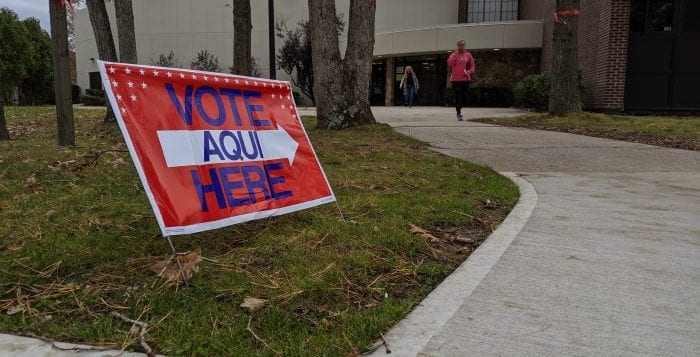Participate in the upcoming Bond Referendum Vote
As the elected board of trustees of the Smithtown Special Library District, we are writing to urge all district residents to participate in the upcoming bond referendum vote on Tuesday, July 1. As our community is aware, the storm last August devastated the lower level of our Smithtown Building, located at One North Country Road.
Like many patrons, we ourselves were heartbroken by the damage that occurred. The lower level was so much more than just a place to store library materials. It represented the space to gather and connect with one another in our Community Rooms, a place for our patrons to explore their creativity and imagination in the Learn Lab – and, of course, a place to research and honor our region’s rich history in The Richard H. Handley Collection of Long Island Americana, otherwise known as the Long Island Room.
While we are grateful to have reopened the first level of the Smithtown Building last month, there is more work to be done. Through the bond referendum proposal, we look forward to not only restoring what was lost in the storm – but reimagining the space and the services we offer to best meet the needs of our community.
Through our “reimagining,” we look forward to introducing a podcast studio and the Federal Depository Library Program – both initiatives that were planned prior to the storm but were paused due to the building’s closure. In addition to housing the Federal Depository Library Program, our expanded Government Services Department will house the Patent and Trademark Resource Center and Passport Acceptance Facility.
As trustees, we have heard the voices of our neighbors who miss the programs and spaces that brought us together. We see this as an opportunity to honor the library’s legacy while positioning it for the future for all residents in our community – from infants to seniors.
We invite all community members to learn more about the proposal by visiting the library’s website at www.smithlib.org. Please also join us for a Community Open House at our Smithtown Building, located at One North County Road, Smithtown, on Tuesday, June 24, from 7:00 to -9:00 p.m.
Thank you in advance for your participation on July 1. As a reminder, polls will be open from 9:30 a.m. to 9:00 p.m. at all four library buildings. We look forward to seeing you there!
Sincerely,
The Smithtown Library Board of Trustees
Research takes time, commitment & patience
When people think of science, they often picture breakthroughs: a new drug, a prosthetic device, an app for mental health. But science also begins with quieter questions.
I study maternal behavior in mice at Cold Spring Harbor Laboratory. I watch as a mother retrieves her scattered pups and brings them back to the nest. It is a simple act, but it reveals something powerful: the brain has circuitry for care.
In the Shea Lab, I ask what allows that care to happen. Which neurons fire when a mother searches for her pup? How do cues like sound or smell spark motivation? These are basic questions with no immediate product. But they form the foundation for understanding caregiving across species.
Some caregivers, in any species, do not respond in expected ways. In humans, postpartum depression, trauma or stress can alter parenting. To understand those disruptions, we must first understand how care functions when things go right. That begins in the brain. That kind of understanding depends on model systems we can study closely, like mice.
This work is often hard to fund. It is not linked to a clinical trial or a startup. It does not come with urgency built in. Yet without it, we would not know where to begin. Foundational studies in rodents showed how hormones like corticotropin-releasing hormone can disrupt maternal care. That early research helped uncover how stress alters brain circuits tied to bonding and motivation. These insights now shape how we approach mood disorders like postpartum depression.
Basic research like this is increasingly under threat. Studies that include terms like maternal or reproductive are sometimes stalled or rejected for political reasons rather than scientific ones. The result is a narrowing of what gets supported.
If we fund only projects with immediate payoff, we lose the slow, essential work that makes future breakthroughs possible. Basic science is not a detour. It is the path.
Model organisms are not a limitation. They are a strength. They allow us to ask precise, causal questions we cannot ask in humans. That is how we build maps of brain function and uncover principles that scale to complex systems.
Science needs time and space to explore. If this matters to you, speak up. Ask what kind of science your institutions support. Advocate for policies that protect curiosity-driven research. The science that teaches us to ask better questions is worth defending.
Hoda Tromblee, Cold Spring Harbor
Close the wage gap for people with disabilities
Organizations in New York can pay a person with a disability as little as $0.05 per hour, and it is legal. This must end.
It’s time for New York to eliminate the subminimum wage and treat people with disabilities with the fairness they deserve. The New York State Senate has passed Bill S28 to do just that, and now it is time for the Assembly to act before their session ends.
As the father of John Cronin, a young man with Down syndrome, I’ve seen firsthand what people with differing abilities can accomplish when given the chance. John co-founded a business with me, John’s Crazy Socks, and we have learned that hiring people with differing abilities is not charity, it’s good business. More than half of our employees have a disability. They work hard, deliver incredible results and earn the same wage as their colleagues.
The subminimum wage law, a relic of 1938, allows people with disabilities to be paid as little as 5 cents an hour. That’s not just outdated, it’s wrong. It tells people that their labor, and their lives, are worth less.
New York should lead the nation by ending this discriminatory practice. No exceptions. No more second-class workers. I urge the State Assembly to pass A28 and help build a more inclusive and just future for all.
Mark X. Cronin, Farmingdale
SCWA is doing good work
It was with pleasure that I read about how “Suffolk County Water Authority achieves full compliance with federal PFAS standards — six years early” [TBR News Media, June 12]. I live behind one of those “17 granular activated carbon (GAC) treatment systems for PFAS” and while I was dubious about those two big green tanks that they erected on their property, I was informed of their purpose and now we see the result. Bravo. It will be a pleasure to pay Suffolk County Water Authority bills in the future.
Bruce Gaugler
Port Jefferson Station
An Open Letter to Gov. Kathy Hochul
Residents of the hamlet of Port Jefferson Station/Terryville, and our neighbors in Setauket and Village of Port Jefferson, bore the burden for years of the egregious pollution for profit at the hands of the disgraced owner of Lawrence Aviation. The concern for public health and safety was a significant concern for decades. Thankfully, the cleanup by EPA of this Superfund site rendered the parcel suitable for redevelopment giving hope to many of us who worked tirelessly to turn lemons into lemonade. We now can realize a public benefit, securing a bright and clean energy future where there once was blight and danger. The Suffolk Landbank worked together with stakeholders to develop plans to provide open space, a solar energy farm and a potential new MTA rail yard for the Long Island Rail Road on 40 acres of the property.
In the past, 40 acres and a mule were offered to provide economic self-sufficiency to those deserving a better future. The ability to retain the potential for the electrification of the Port Jefferson Branch of the LIRR will play a significant role in ensuring residents in our area and ridership along this line can join the modern era of clean and convenient transportation. This opportunity could be the “engine that drives” the resurgence and planned growth of our region with true transit-oriented development, adding to our economic self-sufficiency. Unfortunately, the mule in this case is the stubborn intransigence of the Department of Transportation that, for reasons that defy logic, threatens this entire undertaking based on a potential highway that will never be built.
This can easily be resolved with an easement agreement to address this issue. However, the original deal with the MTA to move this vision forward must be concluded by June 30, 2025, well before any final understanding with DOT can be worked out. We strongly request your immediate intervention to ensure this project can move forwawrd and the will of the people locally not be thwarted by bureaucratic dithering. We need your help to realize the better future we deserve by squeezing DOT to pay $10 to get this deal done and help us make some lemonade!
Ira Costell, President
Port Jefferson Station/Terryville Civic Associatio
WRITE TO US … AND KEEP IT LOCAL
We welcome your letters, especially those responding to our local coverage, replying to other letter writers’ comments and speaking mainly to local themes. Letters should be no longer than 400 words and may be edited for length, libel, style, good taste and uncivil language. They will also be published on our website. We do not publish anonymous letters. Please include an address and phone number for confirmation. Email letters to: [email protected] or mail them to TBR News Media, P.O. Box 707, Setauket, NY 11733
















